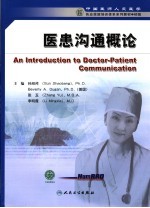

医患沟通概论PDF电子书下载
- 电子书积分:7 积分如何计算积分?
- 作 者:孙绍邦等主编
- 出 版 社:北京:人民卫生出版社
- 出版年份:2006
- ISBN:7117080698
- 页数:96 页
第1章 医患沟通的重要性(Importance of Doctor-Patient Communication) 1
医患沟通真的有问题(Doctor-Patient Communication Is Problematic) 1
证据(Evidence) 1
原因(Causes) 2
改善医患沟通的重要性(Importance of Doctor-Patient Communication) 4
对病人的治疗需要沟通(Communication is An Integral Part of Medicine) 4
有效医患沟通益处多(Benefits of Doctor-Patient Communication) 5
医患沟通正在成为医生资格认证与其他业务考核中的必考技能 9
参考文献(Reference) 10
第2章 一个医患沟通的能力模型(A Competency-Based Structure of Doctor-Patient Communication) 13
能力的定义(Definition of Competency) 13
什么是能力模型?(What is Competency Model) 13
从多个角度来了解医患沟通能力(A Multi-Perspective Understanding of Doctor-Patient Communication) 15
我们的医患沟通能力模型(A Competency Model of Doctor-Patient Communication) 18
澄清一些错误观念(Some Common Mistaken Assumptions Upon Doctor-Patient Communication) 18
了解一些学习的方法(Common Training/Learning Methods) 21
了解自己的学习需要(Identify Learning Needs) 21
Communication Skills) 21
提高医患沟通技能的途径(How to Improve Doctor-Patient 21
参考文献(References) 22
第3章 职业化及医学道德:医患沟通的基础(Professionalism and Medical Ethics:Foundation of Doctor-Patient Communication) 23
医患沟通基本能力之一:职业化的态度与服务能力(Basic Skill one:Professional Attitude and Services) 23
什么是职业化(What is Professionalism) 23
医患关系的特殊性(Characteristics of Doctor-Patient Relationship) 24
医学职业道德(Medical Ethics) 25
以价值观表述的医德原则(Value-based Ethics) 25
以条文定义医德(Rule-based Ethics) 27
医德与医患沟通之间的关系(Relationship Between Medical Ethics and Doctor-Patient Communication) 27
如何提高医生的职业道德水平(How to Educate Medical Ethics) 28
职业道德与个人性格之间的关系(Relationship Between Professionalism/Ethics and Personality) 28
以能力模型为基础来设计医德培养的内容及其培养方法(Competency-based Medical Ethics and Its Development) 29
小结(Summary) 31
参考文献(References) 32
医生需要掌握非言语沟通技巧(Nonverbal Communication Skills is 33
Important to Doctors) 33
第4章 非言语沟通及其技巧(Nonverbal Techniques in Doctor-Patient Communication) 33
医患沟通基本能力之二:非言语表达与解读能力(Basic Skill Two:Nonverbal Expression and Interpretation) 33
有关非言语沟通的基础知识(Basics of Nonverbal Communication) 34
肢体动作语言(Body Language) 35
言语中的音素(Paralinguistic Speech Characteristics) 36
利用物件进行沟通(Object Communication) 36
注意与病人谈话的场景的布置(Settings) 37
给病人留下良好的第一印象(Initial Impression is Important) 37
非言语沟通在临床访谈中的应用(Apply Nonverbal Communication Skills in Clinical Settings) 37
空间距离与位置(Space and Relative Positions) 37
让病人先坐下(Taking A Seat) 38
微笑的神奇效果(Smile) 38
与病人进行目光交流(Eye Contact) 38
注意自己的面部表情(Facial Expression) 38
注意身体的姿态(Position) 38
注意自己的肢体动作(Movement) 39
注意说话的风格(Speaking Style) 39
理解病人的非言语信号 39
参考文献(References) 40
医患沟通基本能力之三:主动倾听能力(Basic Skill Three:Active Listening) 41
第5章 主动倾听技能(Active Listening) 41
认识一些阻碍我们聆听别人的坏习惯(Common Bad Listening Habits) 43
倾听的基本原则(Basic Principles of Active Listening) 44
听别人说话需要发挥主动性(Be active) 44
倾听说话者的心声(Listening to speaker's heart) 45
在聆听别人说话时给予说话者尊重与肯定(Respect and confirm) 45
在聆听别人说话时先别想如何回应(Avoid thinking your response immediately) 46
倾听的具体技巧(Specific Listening Skills) 46
用说话来帮助倾听(Listening by talking) 47
保持安静(Let the patient talk without interruption) 47
避免就某个问题或事实进行直接争论(Avoid debate) 48
参考文献(References) 50
第6章 言语表达技能(Expressing and Explaining Skills) 51
医患沟通基本能力之四:口头表达能力(basic skill four:oral expression and explanation) 51
谈话开始建立和谐关系的说话技巧(Establish Rapport Relationship) 51
见面的互相介绍很重要(Name patients and introduce self) 51
尽量从积极的角度说话(Deliver positive view) 52
在开始谈论一个重要话题时先征询对方的同意(Ask for permission) 52
表达得更完整更清楚一些(Express More Completely and More Clearly) 53
把意思表达得完整一些(Express more completely) 53
用心说话(Speak with your heart) 53
自己要尽量放松(Relax yourself) 53
要说得清晰明白(Speak more clearly) 54
学会准确表达内心的感受(Know How to Express Internal Feelings) 55
说话要会随着场合的变化而灵活变通(Adjust Conversation Style to Audience) 55
向对方问问题的技巧(Ask Questions) 56
在对病人进行身体检查的过程中进行适当的交流或予以适当的解释的技能(Talking with Patient During Physical Exam) 56
战胜自我是提高说话技能的关键(Improve yourself) 57
医患沟通基本能力之五:谈判与化解冲突的能力(Basic Skill Five:Neogotiation and Conflict Resolution) 59
第7章 化解冲突的沟通技能(Resolving Conflicts) 59
医生与病人的特殊关系(Special Relationships of Doctor and Patient) 60
冲突的种类(Types of Conflicts) 60
事实冲突(Data Conflict) 60
关系冲突(Relationship Conflict) 61
价值观的冲突(Value conflict) 61
资源冲突(Resources conflict) 61
历史事件引起的冲突(History conflict) 61
结构性的冲突(Structure conflict)…………………………………………………6l 61
心理方面的冲突(Psychological conflict) 61
为对方消气的技巧(Diffuse patient's anger) 62
应对冲突的沟通技巧(Communication Skills of Resolving Conflicts) 62
管理好自己的情绪(Manage own emotion) 62
理解与同情(Express understanding and show empathy) 63
鼓励对方把内心的想法与感受都说出来(Invite patient to talk) 63
注意说话技巧,避免责怪对方(Avoid to blame) 63
探究式的问话(Know how to ask questions) 64
应对病人抱怨的说话技巧(Deal with patient's complaint) 64
参考文献(References) 66
强烈的悲痛感(Strong grief) 67
人们在危急状态下的通常反应(Common Reactions to Crisis) 67
为什么危机情况下沟通会变得困难呢(Why Is Communication Difficult Under Crisis) 67
第8章 危机情况下的沟通技能(Communication Under Crisis) 67
危机后的心理失调现象(Adaptation problems) 68
与危机患者沟通需要注意的方面(Communication with Patient Under Crisis) 69
与危机患者沟通的一些基本原则 69
给予支持与帮助(Support) 69
鼓励并引导患者说出自己的感受(Encourage patient to express internal feelings) 70
给予希望(Give hope) 70
检查患者的沟通准备状态(Check patient's readiness for communication) 70
注意维护自己的安全感(Protect Your Own Safety) 71
为患者提供信息(Provide sufficient information) 71
参考文献(References) 72
第9章 如何应对难缠的病人(Deal with Difficult Patients) 73
什么样的病人算是难缠的病人(Who Are Difficult Patients) 73
难缠的病人在行为与心理上的表现(Behavioral and psychological characteristics of difficult patients) 74
难缠病人难缠的一些潜在原因(Common reasons causing patients to be difficult) 74
病人难缠有时候责任在医生(Doctor Factors) 74
如何有效应对难缠的病人(How to Deal with Difficult Patients Effectively) 75
几点大的建议(General suggestions) 75
与病人沟通(Communication with patient) 76
与自己沟通(Communication with yourself) 76
在必要时与同事沟通以寻求帮助(Communication with colleagues) 78
如何与异性病人进行有效沟通 78
与异性病人沟通困难的原因 78
与异性病人进行有效沟通的办法 79
参考文献(References) 82
第10章 团队合作及沟通能力(Teamwork and Team Communication) 83
团队的概念(Definition of Team) 83
团队沟通技能(Team Communication) 84
协调能力(Coordination) 87
适应能力(Adaptation/Flexibility) 87
团队互作的其他重要技能(Other Essential Teamwork Skills) 87
团队精神(Team orientation) 87
合作决策与问题解决能力(Cooperative decision-making/problem-solving) 88
团队的领导能力(Team leadership) 88
参考文献(References) 89
第11章 应对压力的技能(Skills of Coping With Stress) 91
压力的定义(Definition of Stress) 91
医生职业与压力(Doctors and Stress) 92
应对压力的常见方法(Effective Ways of Coping with Stress) 92
睡眠(Sleep) 93
常规性的锻炼(Regular exercise) 93
放松(Relaxation) 93
劳逸结合(Balance between work and leisure) 94
期望要比较现实(Realistic expectation) 94
生活支持系统(Social support) 94
幽默(Humor) 95
提高自我管理技能(Self management skills) 95
参考文献(References) 96
- 《全国高等中医药行业“十三五”创新教材 中医药学概论》翟华强 2019
- 《海绵城市概论》刘娜娜,张婧,王雪琴 2017
- 《药学概论》于海平主编 2019
- 《新闻心理学概论 第6版》刘京林 2019
- 《当代食品科学与技术概论 第3版》(中国)王建林,李海燕 2017
- 《无机材料晶体结构学概论》毛卫民编著 2019
- 《环境保护概论》鲁群岷,邹小南,薛秀园主编 2019
- 《生物技术概论 第2版》周选围 2019
- 《马克思主义基本原理概论教学设计与学习指导教程》孙乃龙,李霞 2019
- 《环境科学与工程概论》龙湘犁,何美琴编 2019
- 《指向核心素养 北京十一学校名师教学设计 英语 七年级 上 配人教版》周志英总主编 2019
- 《办好人民满意的教育 全国教育满意度调查报告》(中国)中国教育科学研究院 2019
- 《北京生态环境保护》《北京环境保护丛书》编委会编著 2018
- 《人民院士》吴娜著 2019
- 《民国时期医药卫生文献集成 37》路丽明编 2019
- 《指向核心素养 北京十一学校名师教学设计 英语 九年级 上 配人教版》周志英总主编 2019
- 《民国时期医药卫生文献集成 19》路丽明编 2019
- 《中国人民的心》杨朔著;夕琳编 2019
- 《民国时期医药卫生文献集成 24》路丽明编 2019
- 《基层医疗卫生机构安全用药手册》黎月玲,熊慧瑜 2019
